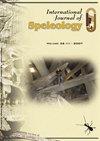沿维也纳盆地转移断裂的硫酸成岩作用和地表地貌演化:Plavecký喀斯特,斯洛伐克
IF 1.3
4区 地球科学
Q3 GEOSCIENCES, MULTIDISCIPLINARY
引用次数: 1
摘要
Plavecký hradný vrch Hill(西斯洛伐克,中欧)的深成溶洞是由断裂的三叠纪碳酸盐岩中的水沿断层上升而形成的,这与mal本文章由计算机程序翻译,如有差异,请以英文原文为准。
Sulfuric acid speleogenesis and surface landform evolution along the Vienna Basin Transfer Fault: Plavecký Karst, Slovakia
Hypogene caves in the Plavecký hradný vrch Hill (Western Slovakia, Central Europe) were formed by waters ascending along faults in fractured Triassic carbonates related to the horst-graben structure at the contact of the Malé Karpaty Mountains and the NE part of the Vienna Basin. The Plavecká jaskyňa and Pec caves mostly contain horizontal passages and chambers with flat corrosion bedrock floors, fissure discharge feeders, wall water-table notches, replacement pockets, as well as a few other speleogens associated with sulfuric acid speleogenesis. The low-temperature sulfuric acid development phases of the Plavecká Jaskyňa are also indicated by the presence of sulfate minerals (i.e., gypsum and jarosite).Subaerial calcite popcorn rims were precipitated from water condensation at the edges of feeding fissures that were still active as thermal vents when the water table dropped. Hydrogen sulfide involved in the sulfuric acid speleogenesis was likely derived from anhydrites and/or hydrocarbon reservoirs with sulfate-saline connate waters in the fill of the adjacent Vienna Basin. It ascended to the surface along deep-rooted sub-vertical fault zones at the contact of the Vienna Basin with neighboring mountains. Three cave levels at 295 to 283 m asl in the Pec Cave, and five levels at 225 to 214 m asl in the Plavecká jaskyňa corresponded to phases of stable local erosional base levels in the bordering part of the Vienna Basin, most likely during periods of strongly decelerated and/or interrupted subsidence. Cave levels separated by vertical differences of only a few meters may also be related to the Pleistocene climatic cycles. The subhorizontal parts of the Pec Cave are probably of late Early Pleistocene age (˃0.99–1.07 Ma?). The two highest levels of the Plavecká jaskyňa developed during the early Middle Pleistocene (˃600 ka). Fine-grained sediments in the passage at 225 m asl with normal magnetic polarity contain jarosite. The middle level of the Plavecká jaskyňa at 220 m asl was formed in the mid-Middle Pleistocene, while the lower and lowermost levels formed in the late Middle Pleistocene (˃270 ka). The water table in the lowermost cave level probably dropped after the tectonic reactivation of the Podmalokarpatská zníženina Depression just in the front of a marginal horst structure of the Malé Karpaty Mountains.
求助全文
通过发布文献求助,成功后即可免费获取论文全文。
去求助
来源期刊

International Journal of Speleology
地学-地球科学综合
CiteScore
3.10
自引率
23.10%
发文量
12
审稿时长
>12 weeks
期刊介绍:
The International Journal of Speleology has the aim to get cave and karst science known to an increasing number of scientists and scholars. The journal therefore offers the opportunity to all scientists working in and on karst to publish their original research articles or their review papers in an open access, high quality peer reviewed scientific journal at no cost. The journal offers the authors online first, open access, a free PDF of their article, and a wide range of abstracting and indexing services.
 求助内容:
求助内容: 应助结果提醒方式:
应助结果提醒方式:


